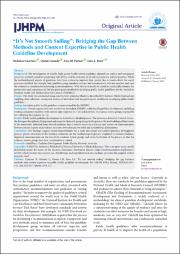“It’s Not Smooth Sailing”: Bridging the Gap Between Methods and Content Expertise in Public Health Guideline Development
(ندگان)پدیدآور
Chartres, NicholasGrundy, QuinnParker, Lisa M.Bero, Lisa A.نوع مدرک
TextOriginal Article
زبان مدرک
Englishچکیده
Background The development of reliable, high quality health-related guidelines depends on explicit and transparent processes, methods aimed at minimising risks of bias and the inclusion of all relevant expertise and perspectives. While the methodological aspects of guidelines have been a focus to improve their quality, less is known about the social processes involved, for example, how guideline group members interact and communicate with one another, and how the evidence is considered in informing recommendations. With this in in mind, we aimed to empirically examine the perspectives and experiences of the key participants involved in developing public health guidelines for the Australian National Health and Medical Research Council (NHMRC). Design This study was conducted using constructivist grounded theory as described by Charmaz, which informed our sampling, data collection, coding and analysis of interviews with key participants involved in developing public health guidelines. Setting Australian public health guidelines commissioned by the NHMRC. Participants Twenty experts that were involved in Australian NHMRC public health guideline development, including working committee members with content topic expertise (n = 16) and members of evidence review groups responsible for evaluating the evidence (n = 4). Results Public health guideline development in Australia is a divided process. The division is driven by 3 related factors: the divergent disciplinary background and expertise that each group brings to the process; the methodological limitations of the framework, inherited from clinical medicine, that is used to assess the evidence; and barriers to communication between content experts and evidence reviewers around respective roles and methodological limitations. Conclusion Our findings suggest several improvements for a more functional and unified guideline development process: greater education of the working committee on the methodological process employed to evaluate evidence, improved communication on the role of the evidence review groups and better facilitation of the process so that the evidence review groups feel their contribution is valued.
کلید واژگان
GuidelinesGuideline Development
Public Health
Methods
Australia
شماره نشریه
8تاریخ نشر
2020-08-011399-05-11
ناشر
Kerman University of Medical Sciencesسازمان پدید آورنده
Charles Perkins Centre, Faculty of Medicine and Health, School of Pharmacy, The University of Sydney, Sydney, NSW, AustraliaFaculty of Nursing, University of Toronto, Toronto, ON, Canada
Charles Perkins Centre, Faculty of Medicine and Health, School of Pharmacy, The University of Sydney, Sydney, NSW, Australia
Charles Perkins Centre, Faculty of Medicine and Health, School of Pharmacy, The University of Sydney, Sydney, NSW, Australia





